How to make a film underfloor heating under linoleum: instructions for laying an infrared heating system
Linoleum is a relatively inexpensive and easy to install floor covering. But it does not always tolerate heating well. Therefore, choosing a warm floor under linoleum, it is necessary to focus on a number of factors. You should familiarize yourself with the indicated landmarks, do you agree?
We will tell you which version of the floor heating system is better to choose for laying under a laminated coating. Here you will learn how to install it, what technological rules should be observed during assembly. Based on our recommendations, you can arrange a comfortable living space with your own hands.
The content of the article:
Choosing the right brand of linoleum
There is an opinion that linoleum is a fully synthetic floor covering, which, when heated, releases chemicals hazardous to health, such as phenol.
Also reproach linoleum put a poor ability to tolerate heat. Under the influence of high temperatures, the coating can noticeably deform.

Finally, initially the material was created not to transfer heat, but to protect it from the cold penetrating from below. All this is true, but only partially. Linoleum is notable for easy installation and moderate cost, so it remains an extremely popular floor covering.
Modern technologies and developments have allowed manufacturers to create new types of linoleum. Among them there are those that perfectly transfer heat, tolerate moderate heat without compromising appearance and do not emit any hazardous fumes.
Five main types of linoleum can be distinguished:
- alkyd or griftal;
- nitrocellulose, it is also colloxylin;
- relein or rubber;
- vinyl, or rather PVC;
- natural, known as marmoleum.
Without going into details of the production technology, it can immediately be noted that the first three options for use with a warm floor are categorically not suitable. All of them react poorly to heating, and relin is not at all suitable for use in residential premises.
The most popular version of linoleum is its PVC version. Such a coating is very diverse in design and thickness, relatively safe, and has a pleasantly reasonable price. After installation, the vinyl coating almost always exudes a not-so-pleasant characteristic odor that disappears over time.
Nevertheless, PVC linoleum is not dangerous, it is suitable for rooms in which people live. When buying, it is recommended to study the labeling of the material, on the packaging there should be a note that this coating is intended for installation on underfloor heating systems.
For example, ordinary linoleum may be provided with an additional layer of heat-insulating material, which is absolutely unnecessary above a warm floor.

Natural linoleum, also known as marmoleum, is an advanced word in the market of floor coverings. The composition of the material includes exclusively natural components, such as crushed bark of cork, pine resin and linseed oil, powder limestone and dyes of natural origin.
Of course, when heated, such material cannot emit any harmful substances, only natural fumes. Marmoleum is sensitive to strong heating, so the question of choosing the temperature regime for such a coating has to be approached very responsibly. However, this is also true for vinyl materials.
Marmoleum can be blamed only at a solid price, but the high wear resistance and material safety fully justify such costs. Marmoleum does not change color over time, and also effectively resists fire.
Choosing linoleum for a warm floor, you need to pay attention to the thickness of the material. Too thin a coating will expose all the roughness of the base, in an excessively thick material will reduce the efficiency of heating the room.
Infrared film - perfect
As you know, a warm floor is divided into two main groups: water and electric, one of the varieties of which is the infrared version. The system that emits IR radiation is volatile, because it requires electrical energy to operate.
The film works in a range favorable for coating, which is why it is the infrared warm floor that is considered an excellent choice for installation under linoleum.
As already mentioned, linoleum is sensitive to excessive heat. Even if the consequences of surface overheating do not become immediately obvious, over time they will appear in the form of deformation, softening, swelling, etc.
Optimum for linoleum is considered a thermal power of about 150-230 watts per square meter of heated area. Infrared film provides just such parameters.
The name "film" this material received due to the appearance. This is really a two-layer polymer film, inside of which are carbon heating elements with a unique nanostructure. It is this content that emits infrared radiation that can heat surrounding surfaces.
The heating elements, which look like black strips about 15 mm wide, are connected by contact bars made of copper and silver. The polymer layer reliably protects this structure from damage. Infrared rays are considered not only harmless, but also to some extent useful to people.
It is not difficult to lay a film underfloor heating, since it is not necessary to “wet” the work of filling the screed. This system provides uniform heating of the room, lends itself to automatic adjustment and can be integrated into a system such as “smart home”.
Another positive point is the easy dismantling of the warm floor. If necessary, you can simply remove the floor covering, remove the film and lay it on a new foundation, even in another room. The energy consumption when using film systems is about 30% less than when using an electric heating cable on a similar area.
Preparing for laying a warm floor
Before starting installation, you need to carefully prepare for work. On a plain sheet of paper, you should make a plan of the room, noting on it the places in which stationary pieces of furniture or large household appliances will fit tightly to the floor. It does not make sense to lay infrared film here.
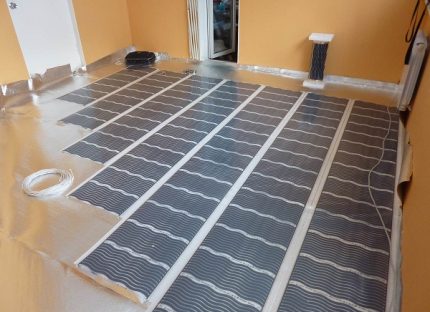
Then make a plan for laying the strip of film. The fewer cut lines, the less connections will be needed, and the easier the installation will be. Therefore, film strips are laid along the long side of the room. When the plan is drawn up, you can calculate the length of the film and the number of connectors that are necessary for installation. On the plan, it should also be noted the location of the temperature sensors and thermostat.
An infrared film and connectors, which are completed in two pieces, temperature sensors and a temperature regulator, as well as bitumen adhesive tape, which acts as an insulator, are usually included in the delivery package of a film warm floor under linoleum.
Additionally you will have to purchase:
- power cable;
- thermal insulation material;
- a film for waterproofing the base;
- contactors (for work with high power systems).
To connect the film floor usually use a copper cable with a cross section of at least 1.5 square meters. mm As a waterproofing material, you can put a layer of polyethylene of at least 0.1 mm. The list of thermal insulation materials that are suitable for a film floor is quite extensive.
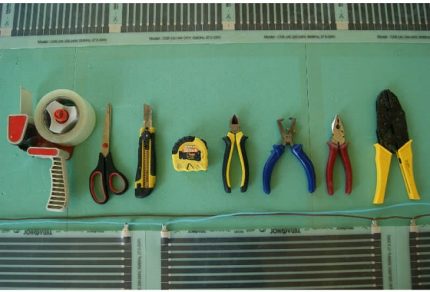
Can be used extruded polystyrene foam, cork materials, liquid composites, etc. Under linoleum, foamed polyethylene or laminated isolon is successfully used.
In any case, you should study the marking of the heat insulator to make sure that the material is allowed to be used with warm floors. The use of heat-insulating material with a metal foil coating is unacceptable.
The most complex tool that you will need during installation is a special tool to crimp contact connectors. But with some skill, ordinary pliers are suitable for this.
In addition, you need to prepare a screwdriver and nippers, scissors and an installation knife for cutting the film, as well as insulation materials, a hammer, etc. In this way, warm infrared floor device linoleum can be made using the most common building tools.
System Installation Guide
If the layout plan for the film has already been drawn up, and all the materials and tools have already been prepared, you can begin work with the preparation of the base. It must be made clean and as even as possible.
The film itself is very thin, less than 0.5 mm. If you lay the material on an uneven base, the heating elements will be subjected to additional loads, and this can cause them damage.
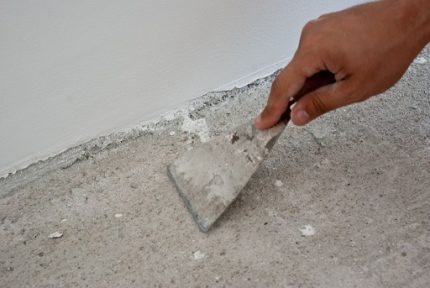
In case of extensive damage, additional work should be done to level the base, for example, pour a new screed over the old base. But if initially the rough floor is fairly even, it is enough to clean it from dirt and dust and eliminate individual differences in height, if necessary.
A layer of thermal insulation material is placed on the prepared base. If this is a rolled material, then usually the strips are laid end to end and fasten the joints with tape. The insulation must lie very evenly, with proper preparation of the base of the problem in this regard, usually does not arise.
Cutting an infrared film into strips of suitable length is a crucial moment. For sections, special places are indicated, indicated by a dotted line. If cut in other places, the film will surely be damaged.
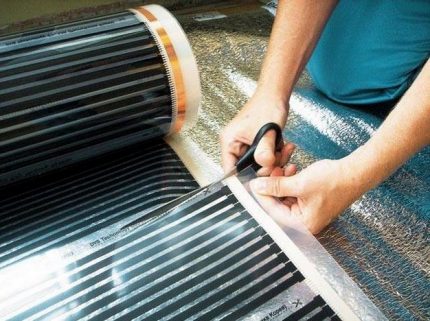
The narrowest piece of film, cut along the dotted line, can be less than 20 cm, and the longest - about 8 meters. This allows you to make strips of the right length in the right amount. The fewer cuts, the easier the installation.
The cut strips of infrared film are laid out in accordance with the plan on top of a layer of thermal insulation material. In this case, the copper strip must be placed with that side up, which is indicated in the instruction by the manufacturer.
The film should be carefully aligned so that it fits snugly against the base. The presence of an air gap between the heating strips and the thermal insulation is unacceptable. After the strips of film are laid, you can begin the installation of contacts.
The connecting clamp is mounted on a copper strip and clamped using a special tool or conventional pliers. The connectors should be installed so that one part of the element is between the layers of the film sheath and attached to the copper bus, and the second part is outside.
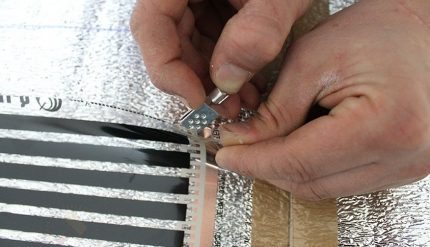
After that, you need to hide under the bits of bitumen insulation all the places where the bimetallic busbar is connected to the power line. All strip contacts not connected to wires also need insulation. They are located on the opposite side of the connection.
After the insulation work is completed, you should use tape to fix the position of the film on the floor so that it does not move during the laying of linoleum.
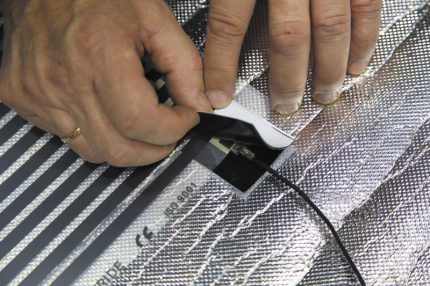
Now need install thermostat. It is usually hung on a wall in an easily accessible place. Connection must be made in accordance with the diagram. Inexperienced electricians, masters at this stage should consult with a specialist. Thermal sensors are placed under the film and connected to the temperature controller by wires.
To hide the cable leading from the thermostat, a wall can be made in the wall. If the repair is already completed, the cable is laid over the wall and closed with a decorative plastic box. At the bottom, a skirting board is used to mask the cable. The edges of the power supply cable are connected using connectors and pressed with pliers.

Then the connection point is isolated. Where the insulation is installed, as well as in the place where the temperature sensor is attached to the film, thickenings will appear. They may complicate further installation of the floor covering.
To avoid this, with the help of a mounting knife, cut the recesses in the layer of heat-insulating material. This will eliminate the difference in height, and the film surface will again become flat.
On this laying of underfloor heating under linoleum can be considered completed, it remains to check the characteristics of the system before installing the floor covering. For this, power is supplied to the film. First you need to use an electric tester to make sure that the insulation is reliable, to check the absence of voltage should be in each isolated area.
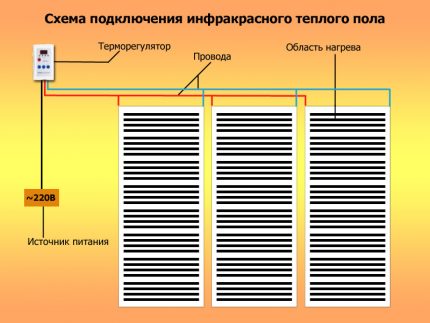
After that, check the degree of heating of each individual strip. If there is no heat, or if some areas are colder or hotter than others, then the installation was not performed correctly. Possible errors should be found and eliminated.
Problems usually arise with such violations as the laying of film strips not end-to-end, but overlap, this position of the heating material is unacceptable. It is also not necessary to cut the film too close to the copper bus, this can cause a violation of insulation. Complete or partial lack of insulation is one of the most common causes of malfunctioning of a warm floor.
Features of laying linoleum
Under linoleum, you also need to prepare the base.First, a layer of polyethylene is laid on top of the infrared film. This material performs the function of waterproofing.
Separate strips are laid with an overlap of 10-20 cm and fixed with tape. In this case, you need to move around the surface of the infrared film very carefully so as not to violate the integrity of graphite heaters.
Then mount a flat surface of fiberboard. This material will reliably protect the warm floor and become a suitable base for linoleum. This type of flooring is delivered rolled up, so before installation it is recommended to spread it out and leave it for several days.
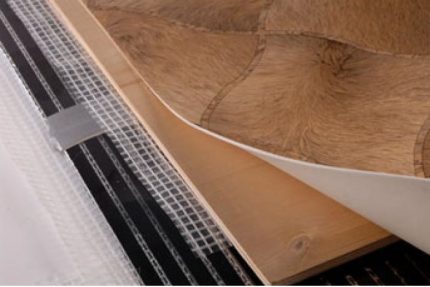
In the case of underfloor heating, the process can be improved. Linoleum lay on the base of fiberboard without fixing, and then include an infrared film. Under the influence of heat, the leveling process will be faster. The temperature regulator should be set at 28 degrees or slightly less. For linoleum, this temperature is considered optimal.
After the coating becomes sufficiently even, it remains only to fix the linoleum on the base. This operation is performed using double-sided tape or glue.
The use of adhesive is considered more suitable for use with underfloor heating, if dismantling and transfer of equipment is not planned. Adhesive provides a snug fit and uniform heating.
With the specifics of floor heating systems on a wooden base and on concrete floor You will find out by reading the articles we recommend.
Conclusions and useful video on the topic
This video demonstrates in detail and clearly the process of laying the infrared floor:
Film underfloor heating is an excellent choice for laying under linoleum. Installation of such systems does not seem too complicated, but it is deceptive simplicity.
When laying an infrared film, it is necessary to strictly adhere to the technology of work and precisely follow the manufacturer's recommendations. This will avoid errors and lay the system correctly to ensure a long service life.
Want to talk about how you arranged a floor heating system with your own hands? Would you like to share information that will be useful to site visitors? Please write comments in the block below, post a photo on the topic of the article, ask questions.

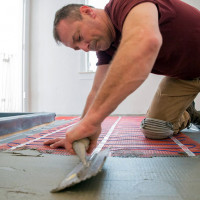 How to make a warm floor under linoleum on a concrete floor: detailed instructions
How to make a warm floor under linoleum on a concrete floor: detailed instructions  Linoleum electric underfloor heating: system advantages and installation instructions
Linoleum electric underfloor heating: system advantages and installation instructions 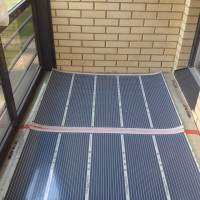 How to make a warm floor on the balcony and loggia: the choice of heating system + installation instructions
How to make a warm floor on the balcony and loggia: the choice of heating system + installation instructions 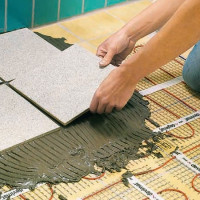 How to make an electric heated floor for tiles: film and cable option
How to make an electric heated floor for tiles: film and cable option 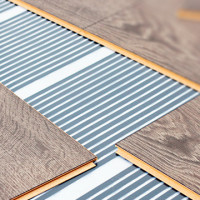 Laminate underfloor heating: installation and installation of a film infrared system
Laminate underfloor heating: installation and installation of a film infrared system 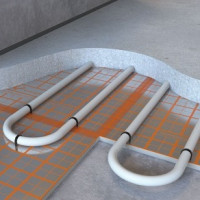 How to make a water heated floor under linoleum: design rules and an overview of installation technology
How to make a water heated floor under linoleum: design rules and an overview of installation technology  How much does it cost to connect gas to a private house: the price of organizing gas supply
How much does it cost to connect gas to a private house: the price of organizing gas supply  The best washing machines with dryer: model rating and customer tips
The best washing machines with dryer: model rating and customer tips  What is the color temperature of light and the nuances of choosing the temperature of the lamps to suit your needs
What is the color temperature of light and the nuances of choosing the temperature of the lamps to suit your needs  Replacement of a geyser in an apartment: replacement paperwork + basic norms and requirements
Replacement of a geyser in an apartment: replacement paperwork + basic norms and requirements
I thought that linoleum is the last century, but it turns out that such interesting varieties of it appeared. I have to choose linoleum forcibly - my daughter does ballet and trains a lot. We equipped a whole hall for her in our country house. In this case, the best flooring is linoleum. We have to deal with light clothes, well, in general, we dreamed about the possibility of making a warm floor and combining this with linoleum. We ourselves, of course, will not install, we will connect specialists. Now we select the marmoleum and we will begin to create our warm floor.
Hello. Marmoleum has low thermal conductivity, so its installation on TP is not always rational.
I always thought that the warm floor and linoleum are incompatible, but it turns out that progress has stepped far. Already a special linoleum was invented for such purposes.
But I don’t see the point, to be honest, except as a necessary measure, like Elena’s. Linoleum is only good for cheapness, and if you buy a special one, even this advantage is lost. So, it is better in the old fashioned way, with a laminate.
I have a film floor, immediately thin linoleum on top, so as not to retain heat. Without glue, because it is harmful to inhale vapors of glue. Yes, and why glue, if we immediately put on the film without plywood.
Due to thermal expansion, linoleum swelled around the edges of the film - that is, it can be seen where the film lies and where it does not ... linoleum heaved up with such islands. But these waves do not bother me, almost not noticeably.
Hello. Vapors of glue are harmful (although there is a different glue), but fumes, combined with constant heating from ordinary linoleum, are also not environmentally friendly.